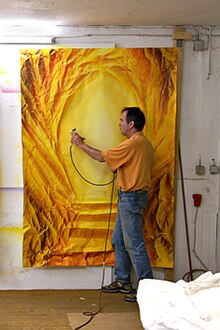Martin Burchard
Martin Burchard (born October 24, 1956 in Stuttgart ) is a German artist . He lives and works in Tübingen. His works unfold in a wide spectrum from small meditation objects to large art installations indoors and outdoors, from painting to meditation paths in nature.
Life
In 1992 Burchard created his first artistic works at the age of 36. Until then, he had never dealt with art and creative design. In the six years until 1998, Burchard worked as a carpenter. The artistic medium of expression in those years was painting, with three-dimensional objects increasingly emerging towards the end of this phase. Burchard: "The artistic work after work and on the weekends was a means for me to improve my psychological balance".
In 1999, Burchard took a sabbatical year and during this time he primarily devoted himself to the production of three-dimensional works of art. Since he was not satisfied with the aesthetic quality of the work, he completed an apprenticeship at the Ulm Academy for Design in Crafts from the end of 1999 to 2002, which he graduated with distinction. At the Academy for Design, classes are taught in the Bauhaus tradition . In Burchard's work, these influences in terms of a reduced formal language are combined with a biographically developed Japonism . During a study trip to Japan, Burchard was deeply impressed by the aesthetics of Zen Buddhist art, architecture, temples and gardens and was fundamentally shaped by it.
In 2002, Burchard decided to start his own business as a freelance artist. Since then, a complex work has been created in different areas of the visual arts: painting, sculptures, objects, meditation rooms as well as large indoor and outdoor art installations. The materials used are also very heterogeneous: wood, steel, concrete, glass, large sheets of paper, gift ribbons, mirrors, gold leaf, painting and much more. In addition to numerous commissioned works and exhibitions, Burchard's works are also used in school books and various other print media. Aside from his artistic training, Burchard is a qualified pedagogue and carpenter.
The concept of art - folk art
For Burchard, it is important to transport intended horizons of meaning as effectively as possible using visual communication. In this context, Burchard's work is more like advertising communication than what is commonly referred to as art these days. It is important to him that the work has as broad an impact as possible in large parts of the population. Burchard also uses slogans and texts to increase the effectiveness of the transport of the intended horizons of meaning. This reflects a utilitarian attitude towards his work. B: “A lot of artifacts that are produced in the art business today are, in my opinion, primarily decoration and ornament for an educated audience. My goal, on the other hand, is to make broad-based folk art that is understandable and that also works, in the spirit of 'form follows function' which actually comes from the field of product design. "
Art - therapy - pastoral care
Burchard intends to design his works in such a way that they can also be perceived as visual therapy and pastoral care impulses. In this context he speaks of 'life-enhancing folk art'. He recurs thereby u. a. to the fact that anti-depressants are the most frequently prescribed medication in Germany and that burnout and depression and other psychological disorders are reported very often. B: “In my opinion, many people are obviously in need and in need of positive energy. My life-serving folk art should work precisely into this need. "
Art - Spirituality
Spirituality is an important dimension in Burchard's work. He assumes that spirituality as a form of energy can contribute to improving conditions in the globalized world. He regards spirituality as the most useful tool in dealing with states of greed, production noise, consumer fever, conflicts, violence and personally experienced stress. B: "I want to promote a spiritual lifestyle with my work and the saying 'Spirituals of all countries unite' fits well with what I intend."
Burchard himself is a Christian . He is convinced that a Christian-spiritual lifestyle has more positive things to offer than its often bad reputation suggests. He approaches other religions with appreciation, esteem, respect and the desire for peace-building cooperation.
Works (excerpts)
Land-Art - outdoor art
- 2010–2014: Meditation Path , State Garden Show Schwäbisch Gmünd
- 2011–2012: Sculpture Ps. 139 , Bernhäuser Forst Stuttgart
- 2006–2008: major project 'weiterweg'
- 2012–2019: Weitblickweg Hohenhaslach, art and reflection path
Installations
- 2011: Art campaign 'Ostertuch' , 56 churches in Württemberg
- 2010: Kunstweg in the Diakonie Klinikum Stuttgart
- 2008: 'Way of Peace' . Seven installations, Jakobuskirche Tübingen
- 2005: Advent-Christmas . Six installations, Jakobuskirche Tübingen
- 2003: Easter . Installation in Schlangenbad
- 2001–2005: annual construction of the 'Way of the Cross Part II' , Jakobuskirche Tübingen
Fonts
- Possibilities, chances and limits of visual languages of faith in the multimedia age , in: To believe reizen, Ed .: T. Unger, Lutherisches Verlagshaus, Hanover 2011, ISBN 978-3-7859-1062-7
- Sermon for the Eye - Visual Communication of Christian Spirituality , in: Diakonie und Spiritualität (2/12), Ed .: Hermann Schoenauer, Ecumenical Spiritual Center Neuendettelsau 2012.
Image gallery
Prizes / awards
- 2003: Award for Art in the Year of the Bible
- 2002: Prize for Art 'Bible and Church 2001/2002'
Web links
- About the Martin Burchard studio , accessed on June 5, 2012
| personal data | |
|---|---|
| SURNAME | Burchard, Martin |
| BRIEF DESCRIPTION | German artist |
| DATE OF BIRTH | October 24, 1956 |
| PLACE OF BIRTH | Stuttgart |







